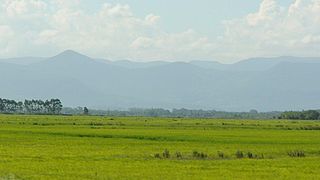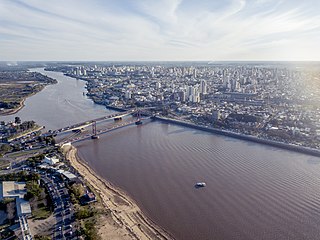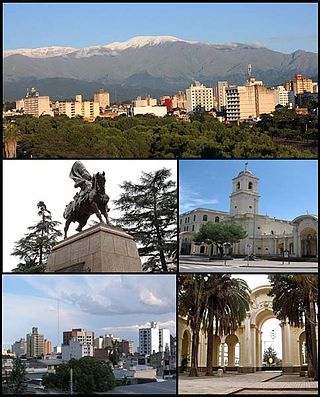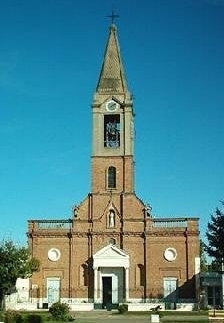
Paraguay is a country in South America, bordering Argentina, Bolivia and Brazil. The Paraguay River divides the country into strikingly different eastern and western regions. Both the eastern region and the western region gently slope toward and are drained into the Paraguay River, which separates and unifies the two regions. With the Paraneña region reaching southward and the Chaco extending to the north, Paraguay straddles the Tropic of Capricorn and experiences both subtropical and tropical climates.

The geography of France consists of a terrain that is mostly flat plains or gently rolling hills in the north and west and mountainous in the south and the east. Metropolitan France has a total size of 551,695 km2 (213,011 sq mi). It is the third largest country in Europe by area and the largest in Western Europe.

The geography of Bolivia includes the Eastern Andes Mountain Range which bisects Bolivia roughly from north to south. To the east of that mountain chain are lowland plains of the Amazon Basin, and to the west is the Altiplano which is a highland plateau where Lake Titicaca is located. Bolivia's geography has features similar to those of Peru which abuts Bolivia's northwest border; like Bolivia, Peru is bisected from north to south by the Eastern Andes Mountains, and these two countries share Lake Titicaca which is the highest navigable lake on Earth. Unlike Peru, however, Bolivia is one of the two landlocked countries in South America, the other being Paraguay which is located along Bolivia's southeast border.

Tatum is a city in Panola and Rusk Counties in the U.S. state of Texas. Its population was 1,342 at the 2020 census.

The Pampas are fertile South American low grasslands that cover more than 1,200,000 square kilometres (460,000 sq mi) and include the Argentine provinces of Buenos Aires, La Pampa, Santa Fe, Entre Ríos, and Córdoba; all of Uruguay; and Brazil's southernmost state, Rio Grande do Sul. The vast plains are a natural region, interrupted only by the low Ventana and Tandil hills, near Bahía Blanca and Tandil (Argentina), with a height of 1,300 m (4,265 ft) and 500 m (1,640 ft), respectively.

Rosario is the largest city in the central Argentine province of Santa Fe. The city, located 300 km (186 mi) northwest of Buenos Aires on the west bank of the Paraná River, is the third-most populous city in the country, and is also the most populous city in Argentina that is not a capital. With a growing and important metropolitan area, Greater Rosario has an estimated population of 1,750,000 as of 2020. One of its main attractions includes the neoclassical, Art Nouveau, and Art Deco architecture that has been preserved in hundreds of residences, houses and public buildings.

Santa Fe de la Vera Cruz is the capital city of the province of Santa Fe, Argentina. It is situated in north-eastern Argentina, near the junction of the Paraná and Salado rivers. It lies 15 kilometres (9.3 mi) from the Hernandarias Subfluvial Tunnel that connects it to the city of Paraná. The city is also connected by canal with the port of Colastiné on the Paraná River. Santa Fe de la Vera Cruz has about 391,164 inhabitants per the 2010 census [INDEC]. The metropolitan area has a population of 653,073, making it the eighth largest in Argentina.

San Salvador de Jujuy, commonly known as Jujuy and locally often referred to as San Salvador, is the capital and largest city of Jujuy Province in northwest Argentina. Also, it is the seat of the Doctor Manuel Belgrano Department. It lies near the southern end of the Humahuaca Canyon where wooded hills meet the lowlands.

Paraná is the capital city of the Argentine province Entre Ríos, located on the eastern shore of the Paraná River, opposite the city of Santa Fe, capital of the neighbouring Santa Fe Province. The city has a population of 247,863.

María Juana is a town in the province of Santa Fe, Argentina, located 125 km from the provincial capital and 210 km from the province's largest city, Rosario. It has a population of about 5,000.

Greater Rosario is the metropolitan area of the city of Rosario, in the province of Santa Fe, Argentina. This metropolis has a population of about 1.3 million thus being Argentina's third most populated urban settlement, after Buenos Aires and Córdoba.

The Salado River is a river that crosses several provinces of Argentina, flowing 1,150 kilometres (710 mi) from its source in the Salta Province to end in the Paraná River, in the Santa Fe Province. Because of its origin, its flow varies widely within the year, and it can dry out in some parts of its path during the winter. The only important tributary to the river is the Horcones River, which is born in Salta as Cajón River, and joins the Salado in the Santiago del Estero Province.

Rafaela is a city in the province of Santa Fe, Argentina, about 96 km from the provincial capital. It is the head town of the Castellanos Department. It has a population of 99,150 per the 2010 census [INDEC].

The Carcarañá River is a river in Argentina. It begins at the confluence of the Río Tercero and the Saladillo River in the south-east of the province of Córdoba and flows eastward into the province of Santa Fe, which it crosses.

The partido of Coronel Suárez is a subdivision of the Province of Buenos Aires in Argentina. In the south-central part of the province, it was created in 1882 by the provincial government when they divided the territory of Tres Arroyos into the partidos of Coronel Suárez, Tres Arroyos and Coronel Pringles.

National Route A006 is a gravel road of 8.5 km (5.3 mi) connecting the town of Las Cuevas on the northwest of the province of Mendoza with the Christ the Redeemer monument in the border between Argentina and Chile. This road is only open in the summer season. It is always important to inquire in the cities of Mendoza or Uspallata on the road conditions as it could be impassable at times. In it winding length it changes altitude from 3,151 m (10,338 ft) to 3,832 m (12,572 ft).

Ceres is a municipality San Cristóbal Department, in Santa Fe Province, Argentina. The town of Ceres is 266 km (165 mi) northwest of the provincial capital Santa Fe and has a population of 16,054 2001 census [INDEC]
German submarine U-988 was a Type VIIC U-boat built for Nazi Germany's Kriegsmarine for service during World War II. She was laid down on 2 October 1942 by Blohm & Voss, Hamburg as yard number 188, launched on 3 June 1943 and commissioned on 15 July 1943 under Oberleutnant zur See Erich Dobberstein.

The Espinal (NT0801) is an ecoregion of dry, thorny forest, savanna and steppe in Argentina. It has been extensively modified by large scale cattle ranching, but remnants of the original flora remain. It is threatened by the advance of the irrigation-based agricultural frontier.

Ataliva is a town in the department of Castellanos in the province of Santa Fe, Argentina. Founded at the end of the 19th century, it maintains some of the characteristics of the rest of the colonies: it is from the beginning a purely agricultural colony, with a population coming from a mostly Italian immigration process. It is the tenth most populated town in the Castellanos department; and the 106th in the province of Santa Fe. In 2010 it had a population of approximately 2100 inhabitants.


















